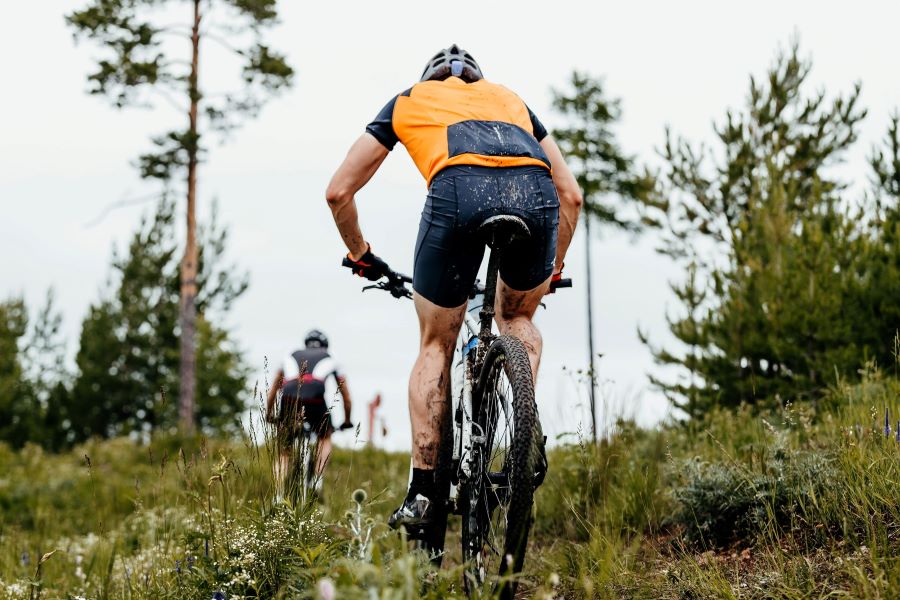This post may contain affiliate links. If you click an affiliate link and make a purchase, I may earn a commission. Also, as an Amazon Associate, I earn from qualifying purchases.--
Here is the quick answer to why cycling is a good leg workout:
Cycling targets your quads, limbs, knees, and calves. It improves the overall function of the lower body and strengthens the leg muscles without overwhelming them.
When I was a teenager, I used to love cycling around in the suburbs. On the rare occasion that I went to the city center on my cycle, I had a blast getting through the clogged-up roads on my nifty little two-wheeler. As I grew and started to keep a check on my diet, focusing on workouts, I wondered what kind of exercise cycling was.
So I did a whole load of research and found out that cycling is one of the best leg workouts around.
After understanding these benefits of cycling as a leg exercise I have started to regularly incorporate it into my lifestyle and here are 9 reasons why you should start too!

1. It is the best leg workout for beginners
If you are just started to exercise, and aren’t comfortable lifting with your legs in the gym, cycling can be a simple beginning point. It is quite simple to ride a bike and I’m sure you know how to do it, too.
You can move at your own pace and work your legs out according to your ability.
You can increase the pace, head onto a hilly road on days you want a harder workout, or ride along the city roads when you just want a relaxed workout session.
If you haven’t cycled in a long time and are uncomfortable with outdoor cycling, you can easily get a cheap indoor exercise bike and start!
Indoor exercise cycles provide you with the added benefit of cycling even when it’s dark outside while enjoying your favorite show on the television
2. It is easy for everyone
Cycling is the easiest and most convenient complete leg workout you can do. To start, you need a pair of pads, closed shoes, a helmet and of course a bicycle. If you already have this, you’re ready to start cycling.
You can cycle at the pace you want, starting slow, and gaining speed as you go. If you want to put some extra load on your thighs you can take a hilly road and make your legs work harder.
This is great because if you were to do a leg workout in a public gym, you would have to pay a regular membership fee.
The good news is that you can do simple workouts with a barbell, weighted exercise balls, and kettlebells, or just do bodyweight squats.
All of these will blast your core and build your legs-the engines that make your bike move.
There are alternatives like skipping, simple leg raises, or a variation of squats but these are not workouts everyone can regularly enjoy and definitely don’t have the add-on benefits that cycling has, such as improving your stamina and helping you exercise your aerobics.
3. Cycling is a low-risk workout
With the helmets and proper safety gear, cycling is one of the lowest-risk leg workouts you can find. Cycling is easy on your leg muscles and joints this means that it does not force your body into extreme effort mode. It removes the risk of lifting heavy weights or pushing your limits in the gym.
For people coming out of surgeries or fractures, cycling alleviates their leg work out without straining them, as the seat supports their upper body weight making it a better alternative than going to the gym and doing a weighted gym leg workout.
For people suffering from leg pain, hip pain, or damaged tissues cycling can be an easy way to regain muscle strength.
Cycling strengthens the muscle around the joints in your legs that are weak or are recovering from an injury and helps them boost their recovery.
4. Cycling is safe
Cycling is quite safe when compared to conventional leg workouts.
Working out your legs at home or in a gym involves a lot of risks. If you don’t have a workout partner, you’re exposed to the danger of not handling the weight between one of your reps and can cause major injuries to yourself.
Even if you have a workout partner, you can still be at harm since these exercises are extremely pushing and can easily damage your leg tissues.
However, if you are cycling, the major risk is a road accident which is quite low. Many European countries are now establishing an extensive system of bicycle lanes, including priority signals and advanced stop lines reducing the risk of a road accident.
Although the situation in the US is still a work in progress it is likely to improve with the Vision Zero plan, (Source).
If this still scares you, you might want to look into an indoor exercise cycle. Indoor cycling is a good leg workout, like outdoor cycling it helps you strengthen your leg but with the added safety of being inside.
5. Makes your legs stronger
“Does cycling make my legs bigger?” was the question when I first thought about cycling as a leg workout.
Well, the simple answer is… no. However, that doesn’t mean it doesn’t make them stronger.
Regular cycling is a good way to improve your leg strength. Cycling improves the overall function of your lower body and makes your muscle stronger.
While cycling does not make you gain huge leg muscles, what it does do is tone your quads (also called your thighs) and your glutes (your hips).
One-legged pedaling is also a popular workout you can do while cycling. In this exercise, you unclip one foot, and pedal with the other for a couple of minutes and then do the same with your other leg.
This focuses on your hip flexors and strengthens this muscle.
6. You can have stronger calves
You might not know what the calf muscle is unless you are lifted in the gym like me.
If you did exercise your calves or still do, you know how energy-consuming it is to do some standing calf raises, use a jump rope, or doing some dumbbell jump squats.
But it is important to work your calves out as your calf is made up of two muscles in your lower leg and forgetting this might mean a weak lower leg.
Cycling is known to strengthen up your calves and help with fat loss. This loss of fat makes your legs and your calves leaner. Regular cycling can help build muscle and helps them grow bigger.
Better calves also bring a better posture. You can technically build up hulk-like calves by cycling rigorously if you want but this might not be the most efficient way to do this if you’re primarily interested in creating muscle.
In this case, you are better off doing some more focused exercises along with cycling.

7. It strengthens your leg joints
If your joints hurt a little, cycling is one of the work-out that don’t make your joints feel worse.
Cycling is a low-impact exercise. This means that cycling has very little impact on your joints while you are riding.
Your hips, your knees, and your feet are the primary joints that are involved in cycling. The movement when you pedal helps lubricate your joints, which in return protects the joints from aching and reduces the pain and stiffness you might already feel.
If one is recovering from a joint injury and doesn’t feel very confident in their balance, indoor cycling can be a good alternative to regular outdoor cycling. This sort of workout can be safer and confidence-boosting.
8. Improves your lower body balance
Cycling helps you improve your body’s stability. You might wonder how so?
Well, body stability primarily involves your legs and their ability to help you stand upright.
With cycling you learn to stabilize your body and keep your bike straight while going through corners, you might not realize but you improve your general body balance and coordination.
This improved balance helps you walk, stand, and run better. Body balance and posture are correlated. If you have a good body balance, you are likely to have a good posture.
Cycling workouts are also helpful in improving your body posture.
Body balance tends to weaken with age and lack of exercise, so you must prioritize a leg workout like cycling to avoid losing your balance.
By cycling regularly, you improve your legs’ ability to balance improving body posture and dexterity.
9. It is a low-Impact workout
Cycling is a very popular basic exercise that a lot of people consider as their go-to when they think of doing a workout on their own. It is a low-impact, easy exercise that does not require a lot preparing.
Although when you think of taking out your bicycle to get some groceries or as a routine workout, you might think of running as an easier alternative. At first glance, it might seem that running is easier since it involves less equipment like pads and helmets, etc.
If you opted for cycling over running you will be delighted to know that cycling, compared to running, is a low-impact workout. This means that, unlike running, cycling is not weight-bearing.
When scientists compared groups of exercising people, including long-distance runners and cyclists, they found that the runners experienced 133%-144% more muscle damage (Source).
Being a low-impact exercise means that it is less likely for you to get a leg injury while cycling because of overuse.
In conclusion, while there may be many leg workouts that you might consider if you are looking to grow your leg muscles, and if you, like me, are looking to keep your body in shape, while lightly but regularly working your legs so they keep supporting you through your life; cycling is the perfect workout for you.
The above-mentioned reasons validate that while cycling may be primarily an aerobic workout, it is good leg exercise too!
Cycling is an easy, safe, and low-impact leg workout, perfect for people of all ages.
Whether you are a teenager looking to start working out or an adult trying to stay fit in your schedule, cycling can help you keep in shape and strengthen up your legs while you are at it.
If you haven’t been on a bike for a while, it is always a good idea to consult with your physician before beginning any exercise routine.
With that being said, hope to see you on the road (or trail) soon!
